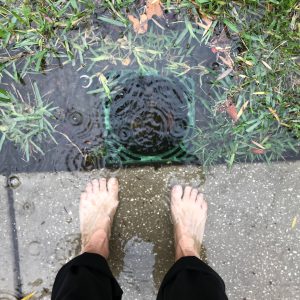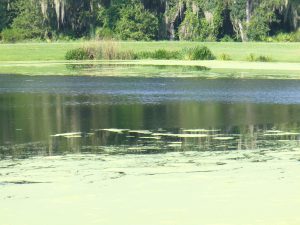Central Florida receives the bulk of its rainfall during the summer months. This rainfall creates stormwater runoff. Stormwater runoff is rainwater that runs off streets, rooftops, parking lots, lawns, and other land surfaces into the closest water body. Excessive irrigation and soil compactions also contribute to runoff.

Lawn and land runoff occurs when the soil has reached its saturation point. This means that the soil cannot hold more water, so the water runs off onto other surfaces. As the water moves over surfaces, contaminants move with the water and get deposited into streams, rivers, lakes, ponds, and Tampa Bay. Below are examples of contaminants.
- Oil, grease and other vehicle discharges
- Pesticides and nutrients from lawns, gardens and agricultural areas
- Viruses, bacteria and nutrients from pet waste and failing septic systems
- Heavy metals from roof shingles and vehicles
- Sediment from eroding landscapes and stream banks, poorly managed construction sites, crops and forests
- Thermal heat from impervious surfaces such as asphalt roads

Contaminants including nutrients contribute to reduced water quality. The nutrients nitrogen and phosphorous are linked to algae blooms. Algae are an important component of ecosystems and provide food for humans, fish, insects, mollusks, and microscopic organisms. Algae blooms frequently occur in warm nutrient rich waters. Some, but not all types of algae produce toxins harmful to humans, other mammals, and fish. Dense algae blooms block sunlight for desirable aquatic plant growth and deplete water oxygen which can lead to fish kills.
The Florida Department of Environmental Protection has listed many water bodies in Central Florida as impaired by nutrients. And citizens are concerned about preserving our water quality for human consumption and enjoyment and for sea life and wildlife.
Counties and local municipalities adopt fertilizer ordinances in an attempt to address negative water quality impacts. Most ordinances restrict applications of nitrogen and phosphorous from June 1 through September 30, when runoff is more likely to occur with heavy rain. However, this is when plants are growing and have the greatest need for nutrients. A few areas restrict applications during winter months when plants have the least nutrient needs.
Fertilizer ordinances contain a lot more than just seasonal restrictions on nitrogen and phosphorous. Ordinances also address:
- Minimum nitrogen slow-release content
- Soil testing
- Application rates
- Requirement for spreader deflector shields
- Removal from impervious surfaces
- Weather restrictions
- Fertilizer free zones
- Management of grass clippings and vegetative materials
- Requirement for training and certifications
- Enforcement and penalties
Use the App linked below to find your county or municipality. Scroll to zoom in and click on your location or use the search bar to enter an address. After a few seconds a right-side bar will open with menu selections containing detailed information. The last menu selection contains a link to the full ordinance for that area.
Florida Fertilizer Ordinance App
For more information on fertilizer and ordinances:
Fertilizer Ordinances: Are They Going Away?
How to Interpret a Fertilizer Label
Summary of Hillsborough County’s Fertilizer Ordinance
For more information visit the UF/IFAS Extension Hillsborough County website or contact Susan Haddock, Professional Horticulture/IPM Agent 813-744-5519 Ext. 54103, szcrmchz@ufl.edu
UF/IFAS Extension Hillsborough County
An Equal Opportunity Institution. UF/IFAS Extension, University of Florida, Institute of Food and Agricultural Sciences, Andra Johnson, Dean for UF/IFAS Extension.
 2
2
